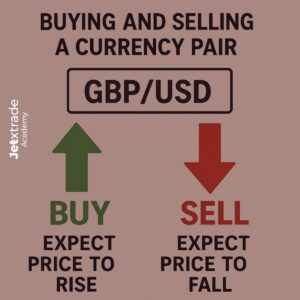Understanding the Forex Market
What is the Forex Market?
The forex market is a global marketplace where currencies are traded. Unlike stock exchanges, the forex market has no centralized location; instead, trading takes place electronically over the counter (OTC). Transactions occur via computer networks connecting traders worldwide.

Key Features of the Forex Market:
– 24/5 Trading:The forex market operates 24 hours a day, five days a week, starting from Sunday at 5 p.m. ET to Friday at 4 p.m. ET.
– Global Reach: Major financial centers such as London, New York, Tokyo, and Sydney facilitate high-volume trading.
– Constant Price Fluctuations: Currency values change dynamically based on economic news, geopolitical events, and market speculation.
[Learn more about the global forex market].
How Does the Forex Market Work?
The forex market is one of the few financial markets that operate continuously throughout the week. It was traditionally dominated by institutional investors, but retail traders have gained significant access in recent years. However, the rise of retail trading has also led to an increase in forex scams.
Where is the Forex Market Located?
Forex trading does not take place in a physical location. Instead, it occurs through trading platforms and computer networks. Key participants include:
– Central and Commercial Banks
– Hedge Funds and Investment Firms
– Retail Investors and Traders
[Read about the evolution of forex trading]
What is Forex Trading?
Forex trading, also known as foreign exchange trading, involves the exchange of one currency for another. This market is highly liquid, with an estimated daily turnover of $6.6 trillion.

Primary Uses of Forex Trading:
1. Speculative Trading:Traders aim to profit from price fluctuations.
2. Hedging: Businesses use forex trading to protect against currency risks.
[Explore the fundamentals of forex trading].
How to Make Money in Forex Trading
Forex trading can be profitable, but it requires strategy, discipline
Common Forex Trading Strategies:
– Going Long: Buying a currency pair expecting the base currency to appreciate.
– Going Short: Selling a currency pair anticipating a depreciation.
– Carry Trading: Earning interest rate differentials between two currencies.
Best Practices for Forex Traders:
– Start small with a micro or mini account.
– Use stop-loss orders to limit risk.
– Avoid excessive leverage.
– Diversify currency pairs.
– Maintain trading records.
[Discover expert forex trading strategies]
Understanding Forex Trading Basics
Buying and Selling Currency Pairs
– Buying (Going Long): Expecting the base currency to increase in value.
– Selling (Going Short): Anticipating the base currency will depreciate.
Forex Trading Spread
The spread is the difference between the buy and sell price of a currency pair. For example, if EUR/USD has a buy price of 1.3428 and a sell price of 1.3424, the spread is 0.0004.

Margin and Leverage
– Margin: The deposit required to open a leveraged position.
– Leverage: A tool that allows traders to control larger positions with a smaller deposit. For example, a 0.50% margin on a EUR/USD trade means only $500 is needed to control a $100,000 position.
[Understand forex spreads and leverage]
How to Start Trading Forex
To begin forex trading, follow these steps:
1. Educate Yourself: Learn about market trends, currency pairs, and economic indicators.
2. Develop a Strategy: Choose from technical, fundamental, or news-based trading approaches.
3. Create a Trading Plan: Define goals, risk tolerance, and trade assessment criteria.
4. Select a Reputable Broker: Ensure the broker is regulated by authorities like the CFTC (U.S.).
5. Practice with a Demo Account: Gain experience before trading real money.
6. Start Small: Begin with small positions to manage risks effectively.
7. Monitor Your Trades: Use stop-loss and take-profit orders to control risks.
8. Stay Updated: Keep track of economic news and geopolitical events.
[Get started with forex trading]
Who is a Forex Broker?
A forex broker facilitates currency trading by providing access to trading platforms. Brokers make money through spreads, the difference between buy and sell prices.

Types of Brokers:
– Market Makers: Provide their own bid/ask prices.
– ECN Brokers: Connect traders to liquidity providers for better pricing.
Risks and Benefits of Forex Trading
Benefits:
– High liquidity and constant trading opportunities.
– Potential for significant profits with proper strategy.
– Market accessibility with minimal initial investment.
Risks:
– High volatility can lead to rapid losses.
– Leverage can amplify both gains and losses.
– Market manipulation and scams.
[Learn how to manage forex trading risks]
Forex Trading Strategies
Traders use different strategies based on their risk appetite and trading style:
– Scalping: Holding positions for seconds or minutes.
– Day Trading: Buying and selling within the same day.
– Swing Trading: Holding trades for days or weeks.
– Position Trading: Long-term trading for months or years.
[Find the best trading strategy for you]
Conclusion
Forex trading offers lucrative opportunities but carries significant risks. Traders must develop a deep understanding of economic trends, risk management, and market analysis. With discipline and strategy, forex trading can become a rewarding financial endeavor.
[Start your forex trading journey today]










